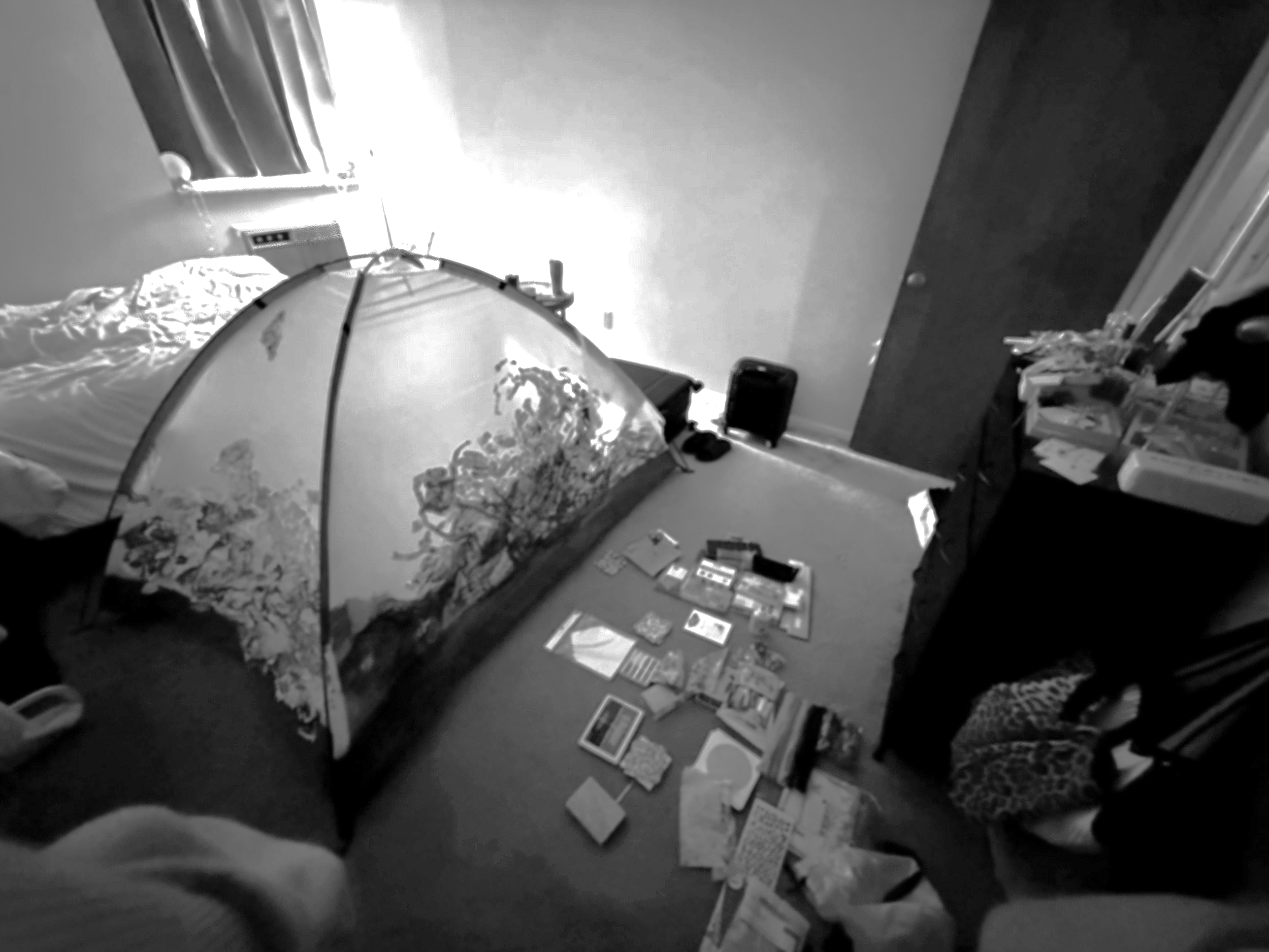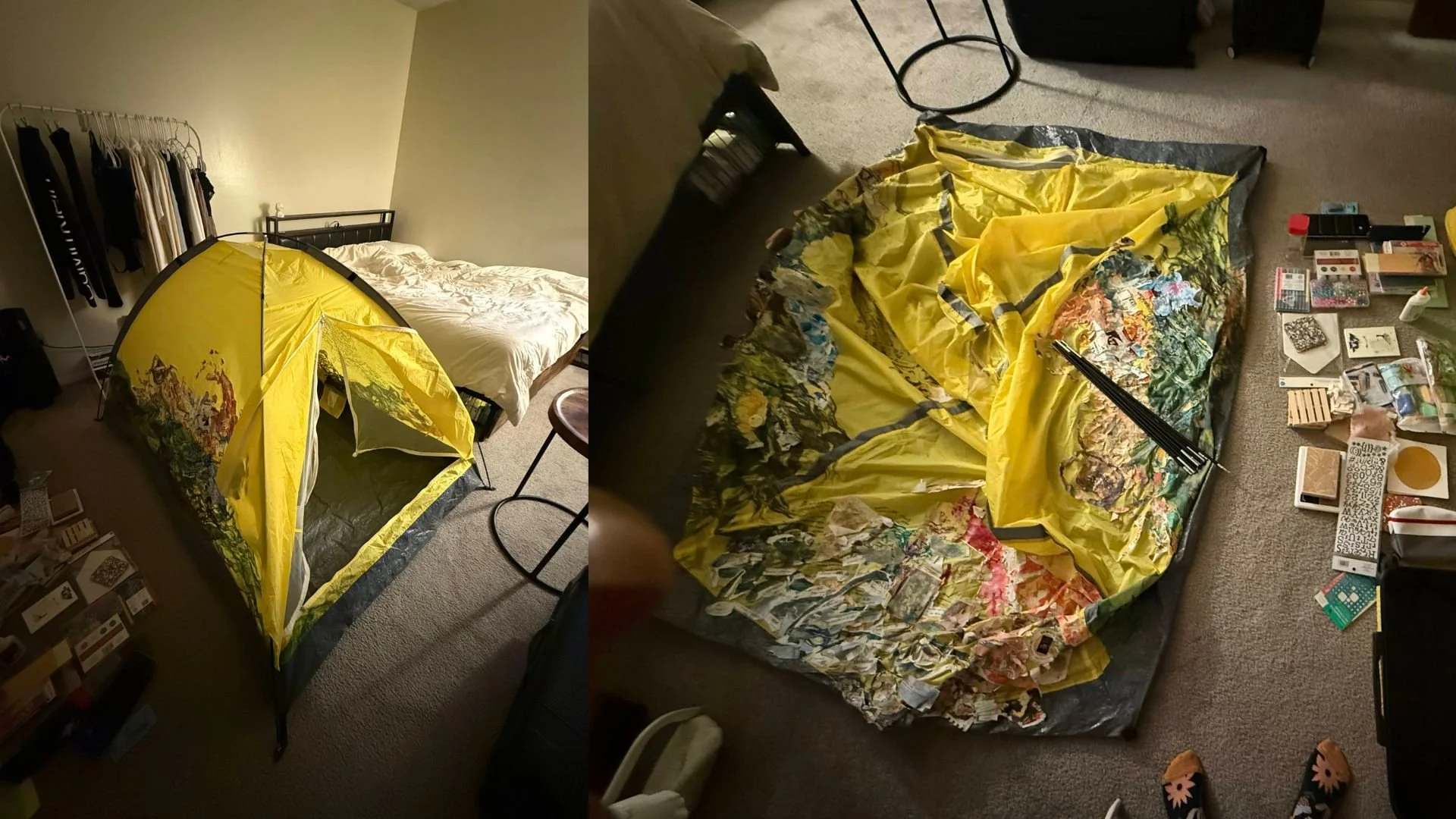
A Candle, A Tent, A Story: Making Space for Transnational Memory

A single candle, flickering beside family photographs and flowered paper, illuminated memories of exclusion, cultural difference, and racialized trauma from South Korea to the United States. Within the glow, stories of the “Asian table,” band-room misunderstandings, and inherited guilt surfaced. The candle’s light softened boundaries between pain and resilience, transforming discomfort into reflection. Inside the tent, memory, body, and flame converged, creating an unstable, fragile yet powerful space for transnational flickering feminist storytelling.
Crossing Amy’s threshold, I carried more than a recorder and art supplies. I carried a research stance formed by institutional expectations and a political moment in which immigrant lives felt precarious. I reminded myself that I was entering a private space filled with routines, invisible labor, and memories that reach from East Asia to the United States. A question followed each step: what does it mean to invite transnational stories inside a room where someone cooks, rests, and heals?
The yellow tent helped me hold that question. It acted as a partner rather than a tool, a material presence that invited co-witnessing, collaboration, and careful listening. Posthuman feminist thought treats discomfort as a motor for change and urges openness to nonhuman and more-than-human forces. I tried to follow that orientation. In Amy’s home, the tent, her bedroom, coffee, snacks, art materials, and—most importantly—a candle formed an entangled field where feelings moved between us. Discomfort settled, then loosened, then returned in waves, guiding the work rather than halting it.
It was my first time setting up the tent in someone’s bedroom. I felt nervous and clumsy. Amy greeted me with warmth and a cup of coffee. She called herself a light lover and showed me lamps shaped like animals, plants, and bottles. Glow mattered to her. Light helped her build a space that belonged only to her. We unpacked the tent together. Our hands lifted poles and fabric, adjusted angles, tested balance, and steadied corners. Slowly a room within a room appeared. Surprise brightened her face. She laughed and said she had not imagined a tent could fit here. She reached for black number stickers and pressed a date onto a yellow panel to mark the moment.
Stories surfaced as we spoke and worked. As a teenager newly arrived from South Korea, she learned cafeteria geography through an unwritten map of race. One corner had an “Asian table.” Placement at that table created a label for difference and a quiet pressure to remain outside the central current. Glances told her what words did not. Later memories carried heavier weight. During her undergraduate years, she heard news of a mass shooting carried out by a Korean man. Shame and guilt washed through her even without any connection to the event. She said that the moment named her outsider status. A sense of alienness settled into the body and stayed.
The candle became central as she began to shape her tent. She placed it near the center, where its steady plastic flame cast flickering shadows across the fabric. Its light animated the yellow surface and the photographs she had chosen of family in South Korea. Each shadow resembled fragments of memory in motion—sometimes vivid, sometimes hazy, yet always alive. Sitting beside the candle, Amy spoke more slowly, her voice layered with both hesitation and resolve. Silence, punctuated by flame, joined the conversation.
We shifted from talking to making. I brought papers, tapes, and pens. Amy brought photographs and the candle. She selected a flowered paper for a tent panel to represent her life spanning many places. She arranged four family photographs along the yellow fabric to introduce parents and childhood impressions. The candlelight animated these images, drawing her fingers to trace their contours as though touching both past and present.
The candle created a ritual. Each time she adjusted its placement or leaned closer to observe its glow, she marked the tent as a space apart from everyday life. The flicker softened boundaries between private memory and public sharing. It made space for grief without drowning in it, and for joy without dismissing pain. Candlelight slowed time, loosening the pace of conversation and creating room for reflection that words alone could not sustain.
She spoke about how gender and race had shaped her silence and restraint. She had learned to suppress discomfort and present optimism in predominantly White settings. Inside the candlelit tent, she allowed other feelings to circulate. The flame’s gentle oscillation mirrored her process: sometimes leaning into vulnerability, sometimes pulling back. For both of us, the candle became a co-researcher, illuminating what was difficult to name and holding it without judgment.
The tent’s modest form held meaning beyond fabric and poles. Arranging photographs, lighting a candle, and sitting side by side created a small migration of the senses. I recalled my own tenting on Spruce Mountain in West Virginia, where tectonic collisions had once lifted and folded the crust into new landscapes. The metaphor felt close. Transnational life pulls and presses a person across languages, places, and expectations until new contours of self begin to appear. The candle flame, like tectonic fire beneath the earth, revealed how tension produces transformation.
Each gesture inside the tent sounded a note of tension: lifting fabric, steadying poles, framing images, lighting the wick. The rhythm rose and fell like a tide. Displacement, adaptation, and resistance threaded through our conversation. The flame kept burning, connecting fragments into a fragile but durable whole.
When we finished, the tent held flowered paper, four photographs, a date in black numbers, and a candle that glowed into the bedroom. The room felt changed, not only by the object but by the relation that formed around it. The yellow tent had acted as co-witness; the candle had acted as keeper of memory. Inside that fabric shelter, discomfort became method, and light became companion. The story that formed did not resolve every wound. It did, however, create a ritual space where Amy could revisit memory without surrendering to harm, and where I could recognize how light—flickering, fragile, persistent—illuminates the work of transnational feminist storytelling.


